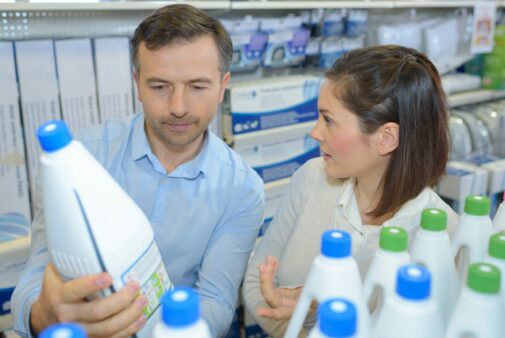
Chemical Ingredients 101: How to Read a Product Label
Ingredient labels for food and other products we use daily often include unfamiliar chemical names. For example, sodium chloride and sodium hydrogen carbonate are often listed on a product label for salt and baking soda.
Why are ingredient labels so complex?
Product manufacturers and chemists routinely rely on technical standards when labeling their products. This helps to ensure quality and consistency. With a little research using credible sources, you can find out why a chemical, or any other specific ingredient, is in a product.
Here are a few examples of chemical compounds in everyday products and the benefits they provide:
Toothpaste Ingredients
- Sodium bicarbonate, commonly known as baking soda, helps to polish teeth.
- Sodium fluoride in toothpaste and other dental care items helps prevent cavities.
- Calcium carbonate, dehydrated silica gels, hydrated aluminum oxides, magnesium carbonate, phosphate salts and silicates aid in the removal of tooth debris and residual surface stains.1
- Sorbitol, a type of sugar derived from fruits, corn and seaweed, helps improve the taste of toothpaste.2
Skin Care Product Ingredients
- Parabens such as methylparaben, ethylparaben, propylparaben, butylparaben, isopropylparaben and isobutylparaben are highly effective in preventing the growth of fungi, bacteria and yeast makeup and shaving cream.
- Preservatives help extend a product’s shelf life and prevent contamination and the growth of harmful bacteria in sunscreens, lotions, shampoos, cleansers, toothpaste and makeup.
- Propylene glycol3 and polypropylene glycols (also known as 1,2-propanediolare) are often in moisturizers, creams and lotions to help attract water to skin. This helps to enhance the skin’s appearance by reducing flaking and restoring suppleness.
- Titanium dioxide is mined from the earth and further processed and purified for use in consumer products like makeup, nail products, bath soaps, foot powders and over-the-counter sunscreen products. Titanium dioxide helps make products white and increases opaqueness. It can absorb, reflect, and scatter light, making it a critical component in some sunscreen products to protect skin from the sun’s harmful ultraviolet radiation.
Soap Ingredients
- Sodium laureth sulfate4 and ammonium laureth sulfate5 help create a soapy lather in products like bubble baths, bath soaps and detergents and shampoos, to help cleanse hair and skin.
- Triclocarban is an antimicrobial product used in soap and antiseptic foaming solutions (foam hand washes and wound care products) to help reduce harmful bacteria on the skin, as well as lessen transmission of germs.6
- Surfactants are typically used in soap to help in the removal of dirt and oil from hair and skin.
Do you have more questions about chemicals in products? The following resources can help:
- Search for specific chemical ingredients on ChemicalSafetyFacts.org.
- CosmeticsInfo.org has detailed information on ingredients used in person care products.7
- Contact the product manufacturer. The product packaging or label should include contact information or a website.
- Websites maintained by federal agencies such as the FDA8 or the U.S. Centers for Disease Control9 also provide useful information about ingredients and labeling.
How to read a chemical label
The U.S. Occupational Safety and Health Administration (OSHA) requires hazardous chemical labeling as a part of its recent revision of the Hazard Communication Standard. All labels are required to have the following:
- Pictograms
- A signal word
- Hazard and precautionary statement
- The product identifier
- Supplier identification
OSHA’s Hazard Communication Standard pictogram provides more information about how to read these labels.10
Sources
- Toothpastes | American Dental Association (ada.org)
- Overview of Food Ingredients, Additives & Colors | FDA
- Propylene glycol | C3H8O2 – PubChem (nih.gov)
- Sodium Laureth Sulfate – Cosmetics Info
- Ammonium Laureth Sulfate – Cosmetics Info
- Triclocarban – Cosmetics Info
- Homepage – Cosmetics Info
- U.S. Food and Drug Administration (fda.gov)
- Centers for Disease Control and Prevention (cdc.gov)
- Hazard Communication Standard Pictogram (osha.gov)

